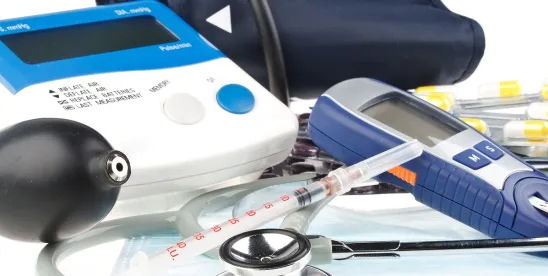The U.S. Department of Justice (DOJ) recently published a final rule on the accessibility of medical diagnostic equipment (MDE) and other accessibility-related practices that promises to have broad impact on the health care industry. Although the rule is limited to state and local government’s healthcare practices, it is likely only a matter of time before the rule’s mandates will be imposed on the entire health care industry.
Quick Hits
- The DOJ issued a rule that requires that a certain percentage of MDE, including examination tables, weight scales, dental chairs, and radiological diagnostic equipment, to be accessible to and usable by individuals with disabilities.
- The new rule requires that acquisitions of MDE after October 8, 2024, begin to account for meeting the scoping requirements referenced above and affirmatively requires governmental healthcare facilities to purchase a certain amount of accessible MDE by August 9, 2026, if they have not already done so.
- The new rule also requires covered healthcare practices to adequately train staff to operate accessible MDE and to assist with transferring and positioning of disabled individuals.
- While the rule technically applies only to state and local government healthcare facilities, it is likely only a matter of time before the same (or stricter) standards are applied to the entire healthcare industry.
The Impact of the Regulation
The new rule goes beyond simply mandating acquisition of accessible MDE; it also imposes an obligation on state and local government entities to train their staff on MDE use and to have knowledge of and assist with transferring and positioning of disabled individuals to and from MDE.
The new rule was issued under Title II of the Americans with Disabilities Act (ADA) by the DOJ, meaning that it is currently limited to state and local governments. Because the DOJ is responsible for regulation under Title III of the ADA and, in conjunction with the U.S. Department of Health and Human Services (HHS), for Rehabilitation Act regulation, these rules will likely be made applicable to all recipients of federal financial assistance and eventually privately owned public accommodations. Moreover, HHS will likely regulate in a similar way under the Affordable Care Act. Thus, these new rules are something likely to soon apply to the entire healthcare industry.
MDE Standards for State and Local Governments
The rule adopts the standards for accessible MDE issued by the Architectural and Transportation Barriers Compliance Board (Access Board), as reflected in 36 C.F.R. Part 1195 (revised as of July 1, 2017) and broadly defines MDE as “equipment used in, or in conjunction with, medical settings by healthcare providers for diagnostic purposes.” Examples of MDE include: examination tables, examination chairs, dental chairs, weight scales, mammography equipment, X-ray machines, and other radiological equipment commonly used by health professionals.
Requirements for Newly Acquired MDE
For MDE that state and local government entities acquire after October 8, 2024, the following requirements apply:
- All newly acquired MDE must meet the MDE standards unless and until the entity has met the scoping requirements.
- Scoping requirements state that at least 10 percent of the total number of units, but no fewer than one unit, of each type of equipment in use must meet the MDE standards.
- In facilities specializing in treating conditions that affect mobility at least 20 percent, but no fewer than one unit, of each type of equipment in use must meet the MDE standards.
- Facilities with multiple departments, clinics, or specialties must disperse their accessible MDE proportionately.
Requirements as of August 9, 2026
Even if state and local government entities do not purchase MDE after October 8, 2024, by August 9, 2026, these entities must:
- acquire at least one examination table and one weight scale that meet the MDE standards if they use such equipment.
Requirements for Services, Programs, and Activities—Staff Training and Transfer
State and local government entities must ensure that their services, programs, and activities offered through or with the use of MDE are readily accessible to and usable by individuals with disabilities.
This includes:
- making services, programs, and activities accessible in their entirety, even if not every unit of MDE is accessible;
- providing services at alternate accessible locations or conducting home visits, if necessary;
- ensuring that staff can successfully operate accessible MDE; and
- ensuring that staff is properly trained and equipped to assist with transfers and positioning of individuals with disabilities. This may require the purchase of transfer boards and ancillary equipment needed for the safe transfer of individuals with certain disabilities. While the ability to transfer and conduct transfer training are now made explicit, it has long been considered a requirement under the ADA to deliver these transfer services to patients with disabilities.
Potential Compliance Flexibility for State and Local Governments
The new rule does maintain defenses generally available under the ADA, including where action would constitute a fundamental alteration of the service, program, or activity being offered or cause undue financial or administrative burdens. They are also not required to alter the diagnostically required structural or operational characteristics of the equipment that would prevent its use for its intended diagnostic purpose.
Alternatives to MDE Standards
State and local governments may also be relieved of MDE standards if they utilize alternative designs, products, or technologies that provide substantially equivalent or greater accessibility and usability. The responsibility for demonstrating equivalent facilitation rests with the public entity.
Key Takeaways
State and local governments may want to immediately inspect their MDE to confirm that their equipment conforms to the scoping requirements and put policies in place to ensure that any new purchased, leased, or acquired equipment conforms to the MDE standards and MDE scoping requirements.
State and local governments may also want to review their internal policies and procedures as they relate to accommodating patients with disabilities, including, specifically, training requirements for safe and effective transfer of and for otherwise accommodating disabled patients challenged by a lack of access to MDE and other equipment used in the practice.
The private healthcare industry may want to plan for the likelihood that these same standards will soon apply to it.
The ability (and training) to safely transfer patients, while now explicit, are widely considered required under existing ADA law for all entities.





 />i
/>i

